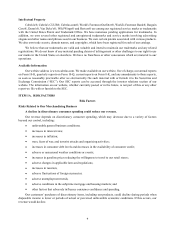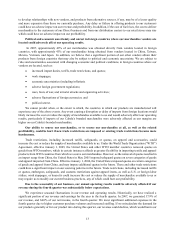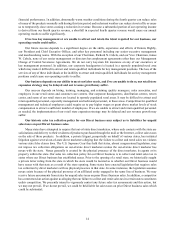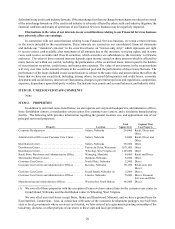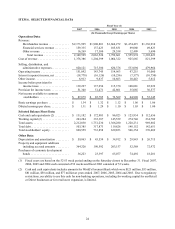Cabela's 2007 Annual Report Download - page 22
Download and view the complete annual report
Please find page 22 of the 2007 Cabela's annual report below. You can navigate through the pages in the report by either clicking on the pages listed below, or by using the keyword search tool below to find specific information within the annual report.16
the future for any of these reasons could cause us to significantly alter our retail store strategy or format. As a result,
we could be forced to invest less capital in our stores which could have an adverse effect on our ability to construct
the stores as attractive tourist and entertainment shopping destinations, possibly leading to a decrease in revenue
or revenue growth. In addition, the failure to obtain similar economic development packages for stores built in the
future would have an adverse impact on our cash flows and on the return on investment in these stores.
The failure of properties to generate sufficient taxes to amortize economic development bonds owned
by us that relate to the development of such properties would have an adverse impact on our cash flows and
profitability.
We often purchase economic development bonds issued by state or local governmental entities in connection
with the development of our retail stores. The proceeds of these bonds are then used to fund the construction and
equipping of new retail stores and related infrastructure development. The repayments of principal and interest on
these bonds are typically tied to sales, property, or lodging taxes generated from the related retail store and, in some
cases, from other businesses in the surrounding area, over periods which range between 20 and 30 years. However,
the governmental entity from which we purchase the bonds is not otherwise liable for repayment of principal and
interest on the bonds to the extent that the associated taxes are insufficient to pay the bonds. At the time we purchase
these bonds, we make estimates of the discounted future cash flow streams they are expected to generate in the form
of interest and principal payments. Because these cash flows are based primarily on future property or sales tax
collections at our retail stores and other facilities (which in many cases may not be operating at the time we make our
estimates), these estimates are inherently subjective and the probability of ultimate realization is highly uncertain. If
sufficient tax revenue is not generated by the subject properties, we will not receive the full amount of the expected
payments due under the bonds, which would have an adverse impact on our cash flows and profitability.
Our failure to comply with the terms of current economic development agreements could result in our
repayment of grant money or other adverse consequences that would affect our cash flows and profitability.
The economic development packages which we have received in connection with the construction of our current
stores have, in some instances, contained forfeiture provisions and other remedies in the event we do not fully comply
with the terms of the economic development agreements. Among the terms which could trigger these remedies are
the failure to maintain certain employment and wage levels, failure to timely open and operate a retail store, and
failure to develop property adjacent to a retail store. At the end of 2007, the total amount of grant funding subject to
repayment pursuant to a specific contractual remedy was approximately $13 million. Other remedies that have been
included in some economic development agreements are loss of priority to tax payments supporting the repayment
of bonds held by us. Where specific remedies are not set forth, the local governments would be entitled to pursue
general contract remedies. A default by us under these economic development agreements could have an adverse
effect on our cash flows and profitability.
We may incur costs from litigation or increased regulation relating to products that we sell, particularly
tree stands and firearms, which could adversely affect our revenue and profitability.
We may incur damages due to lawsuits relating to products we sell. We are currently a defendant in certain
product liability lawsuits, including lawsuits relating to tree stands. We may incur losses due to lawsuits, including
potential class actions, relating to our performance of background checks on firearms purchases and compliance
with other sales laws as mandated by state and federal law. We may also incur losses from lawsuits relating to the
improper use of firearms or ammunition sold by us, including lawsuits by municipalities or other organizations
attempting to recover costs from manufacturers and retailers of firearms and ammunition. Our insurance coverage
and the insurance provided by our vendors for certain products they sell to us may be inadequate to cover claims
and liabilities related to products that we sell. In addition, claims or lawsuits related to products that we sell or the
unavailability of insurance for product liability claims, could result in the elimination of these products from our
product line reducing revenue. If one or more successful claims against us are not covered by or exceed our insurance
coverage, or if insurance coverage is no longer available, our available working capital may be impaired and our
operating results could be adversely affected. Even unsuccessful claims could result in the expenditure of funds
and management time and could have a negative impact on our profitability and on future premiums we would be
required to pay on our insurance policies.





